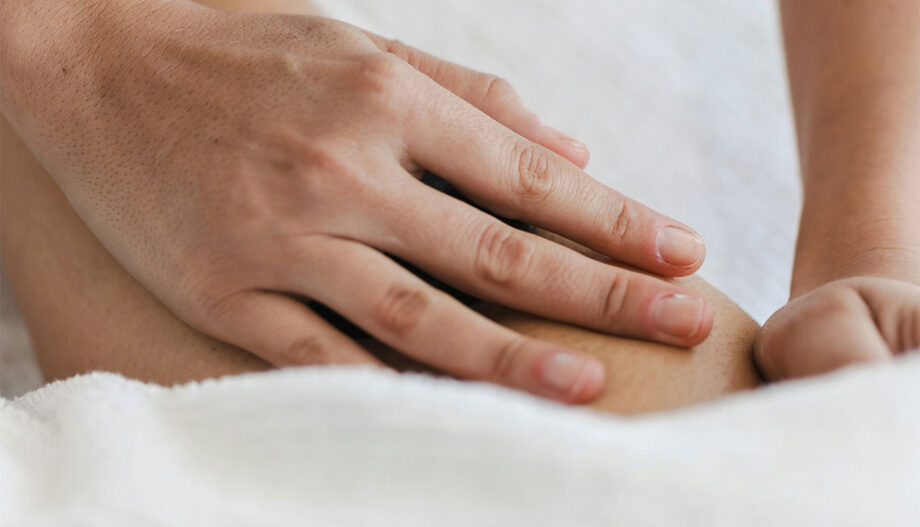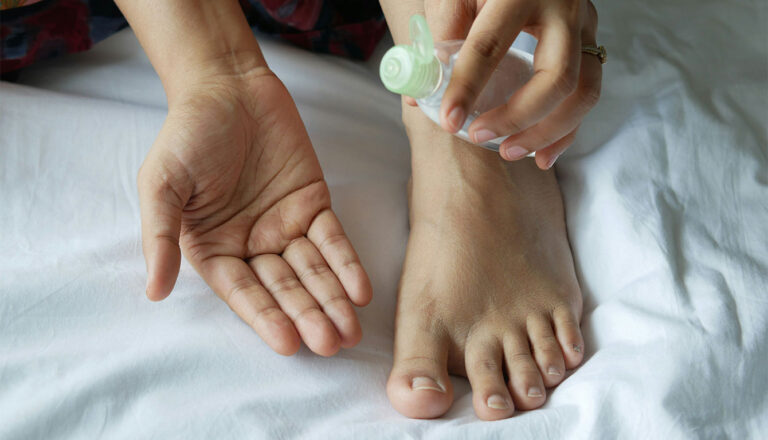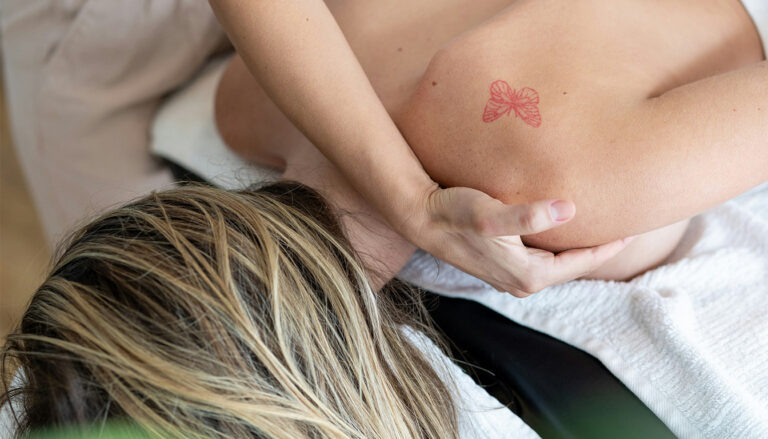Short, friendly guidance for simple home care sits at the heart of this piece. No appointment or gadgets are needed; your hands will do the work. Sessions of around five to ten minutes can offer real relief from daily tension.
The approach uses gentle pressure and small circular motions across the head, neck and shoulders, then moves down the back and foot areas. The flow aims for soothing contact rather than deep intensity. Creating a calm space with soft light and gentle music makes the experience feel like a mini spa.
Regular practice may ease headaches, relax tight muscle groups and support sleep and mood. These techniques complement other self-care habits and prioritise comfort. If pain is sharp or persistent, pause and seek professional advice.
Key Takeaways
- Short 5–10 minute sessions offer quick massage stress relief without fuss.
- Use light pressure and small circles on head, neck, shoulders, back and foot.
- No special tools needed; hands are enough, though a ball can help the back.
- Calm setting, slow breathing and checking comfort are as important as technique.
- Regular use may reduce tension, ease headache symptoms and improve sleep.
Understand the goal: stress relief through safe, gentle techniques
Work with light, steady contact that calms the nervous system and eases built-up tension.
Self-massage techniques use hands or simple tools to knead skin and apply pressure to sore spots. Spend about three to five minutes per area; brief sets often work better than long sessions.
Aim for comfort, not force. Use gentle pressure and slow motions so muscles relax rather than tense further.
- Keep sessions brief and timed — three–five minutes per zone prevents overworking the body.
- Check in often; watch for guarding, flinching or sharp pain and stop if these appear.
- Accept mild ache or warming as normal; numbness, sharp pain or tingling are warning signs.
Good posture helps — a neutral spine and relaxed shoulders protect both giver and receiver. Remember that massage therapy complements medical care; persistent or severe symptoms need professional advice.
Set the scene for relaxation at home
Start small and simple. Begin by turning a living space into a small sanctuary with dimmed lamps and gentle music. A calm backdrop helps the nervous system settle and makes brief sessions feel special.
Create a calm, spa-like atmosphere
Dim lights, reduce noise and clear distractions. Use cushions and a supportive chair or sofa so both of you feel steady and comfortable.
Choose oils or no tools: keeping it simple and soothing
Clean hands, a towel and optional light oil or unscented lotion are enough. Patch-test any oil and apply sparingly; hands-only techniques work perfectly well without products.
Breathing and pacing: five to ten minutes to start
Set a gentle timer for five to ten minutes. Encourage steady nasal breaths: four counts in, six counts out. This pacing aids relaxation and helps avoid overworking sensitive areas such as the feet and neck.
- Many people find a warm room and soft blanket speeds muscle looseness by improving local blood flow.
- Keep water nearby for hydration after the session.
- Remind the other person they can pause or change pressure at any time; consent matters.
| Set-up | Best for | Notes | Approx. time |
|---|---|---|---|
| Hands-only | Quick relief, sensitive skin | No products needed; low slip risk | 5–10 minutes |
| Light oil or lotion | Smoother strokes, feet and back | Use small amount; patch-test first | 5–10 minutes |
| Warm room + blanket | Those who tense easily | Boosts local blood flow and comfort | 5–10 minutes |
How to massage a stressed person: a friendly, step-by-step approach
Begin with gentle, even strokes that warm the skin and invite calm.
Start light. Use slow, light strokes and small circular motions to explore tight areas without provoking pain. Keep hands relaxed and let the pads of the fingers and the heel of the hand guide the glide rather than pokey fingertips.
Check comfort often. Pause every 20–30 seconds and ask about pressure and any sharp or radiating pain. If there is pins-and-needles or intense discomfort, stop and reposition or skip that area.
Sequence overview
Follow a simple flow: head first to soothe the senses, neck next for postural tightness, shoulders and upper back after that, then the lower back and finally the feet. Work one side, then the other, repeating circular motions on each side for balance.
- Use breathable pauses between techniques to let muscles settle.
- If you meet resistance, decrease pressure and slow down rather than digging in.
- Avoid direct pressure on bones and joints; favour soft tissues and muscle bellies.
| Step | Main focus | Why it helps |
|---|---|---|
| Head | Scalp and temples | Calms the nervous system and eases headache tension |
| Neck | Base of skull to shoulders | Releases postural tightness and improves movement |
| Shoulders & back | Upper back and muscle bellies | Soothes upper-body holding patterns and relieves tension |
| Feet | Toes, arch, heel | Grounds the body and finishes the session gently |
Neck massage techniques to ease muscle tension
Gentle, steady moves help tired muscles unwind without strain.
Begin by finding the broad muscles along each side of the neck and using slow glides from just below the ear toward the shoulder. Place knuckles or fingers there and use light-to-medium pressure, repeating on the opposite side.
Opposite-hand squeeze and glide: stand slightly behind the chair. With your right hand, squeeze and glide from below the left ear down to the top of the shoulder. Swap hands and repeat, keeping strokes smooth and even.
Working both sides evenly with small circular motions
Use small, circular motions along the side of the neck. These motions encourage release without pinching delicate tissues. Keep pressure light-to-medium and only increase if the muscles soften and comfort stays steady.
Managing knots safely: firmer pressure with slow head turns
For stubborn knots, hold a gentle point with the pads of your fingers or knuckles. Invite a slow head turn away from the working hand; this lengthens the tissue and reduces strain.
- Avoid pressing the front of the neck or the spine—focus on the broad muscles each side.
- Use thumbs sparingly for short holds and vary with finger pads to avoid fatigue.
- Limit work to 3–5 minutes per side and check comfort, warmth or light-headedness frequently.
- Stop if dizziness, tingling in the arm, or jaw/ear pain appears.
| Technique | Placement | Pressure | Duration |
|---|---|---|---|
| Opposite-hand squeeze & glide | Just below the ear down to top of shoulder | Light–medium | 3–5 minutes per side |
| Small circular motions | Side of neck along muscle bellies | Light, increase only if comfortable | Continuous short rounds |
| Knots with head turn | Firm point on knot | Medium (tolerable) | Up to 3–5 minutes, check often |
For more tips on easing neck pain and improving mobility, see this short guide: neck pain relief and mobility.
Head and scalp massage for stress and headache relief
Gentle scalp work can cut through tension and ease mild headache symptoms.
Start at the hairline and glide fingertips toward the nape, letting each pass soothe the scalp. Repeat this sweep several times to warm the skin and relax the neck.
Hairline to nape sweeps with the fingertips
Seat the client comfortably and use pads of your fingertips for light, even contact. Sweep from forehead across the crown and down to the back of the neck.
Temple press and slow circles to ease eye strain
Place fingers near the ears and glide upwards along each side of the head to loosen surface tension. Then use a soft temple press with slow circular motions to ease eye strain and mild headache sensations.
Finish with full-scalp small circular motions
Explore the crown and sides with small, even circular motions that cover the entire scalp. Keep pressure gentle—scalp tissues respond best to rhythmic, light contact.
- Encourage steady breathing; long exhales deepen relief and quieten stress.
- Spend 2–3 minutes for brief relief or up to 5 minutes if enjoyed.
- Avoid pulling hair; use fingertip pads not nails and lighten touch for sinus pressure or dizziness.
- End with soothing sweeps from hairline to nape to signal completion.
| Move | Placement | Pressure | Duration |
|---|---|---|---|
| Fingertip sweeps | Hairline → nape | Light | 1–3 minutes |
| Side glides | Near ears → up along side of head | Light–medium | 1–2 minutes per side |
| Temple press & circles | Temples | Very light | 30–90 seconds |
| Full-scalp small circles | Crown and sides | Light, rhythmic | 1–3 minutes |
Shoulder massage to relieve upper-back tension
Gently working the shoulder area can reduce holding patterns and ease daily tightness.
Place your hands on the top of the shoulder and make small, even circles. Feel for tight patches and stay on any tender spot for a few breaths until the tissue softens.
Knead the top of each shoulder using thumbs and fingertips
- Stand behind the person and knead with the pads of your fingers, moving across the shoulder blades and upper fibres.
- Alternate broad squeezes with small thumb circles to warm and release the muscles without poking.
- Keep pressure moderate and watch for signs of discomfort—if they raise their shoulders or hold their breath, ease off.
- Spend about 2–3 minutes per shoulder, then switch, keeping work even on both sides.
- Blend shoulder work into the upper back by gliding from the base of the neck to the top of each shoulder and back again.
- If a stubborn knot appears, hold gentle pressure for a few breaths rather than grinding.
- Avoid the bony top of the shoulder and collarbone; stay in soft tissue and finish with lighter strokes to settle the area.
| Main focus | Pressure | Timing |
|---|---|---|
| Top of shoulder & upper fibres | Moderate, responsive | 2–3 minutes per side |
| Blend toward neck and upper back | Light–moderate | Repeat symmetrically |
| Finish strokes | Light | 30–60 seconds |
Back massage at home: hands, tennis ball, and foam roller
A few focused moves with thumbs, a tennis ball or foam roller can offer quick relief for common back aches.
Lower back with thumbs: Sit upright and place both thumbs just to either side of the sacrum. Use small circular motions, moving gently up and down the lower spine. Pause on tense spots for a few slow breaths and then continue; this simple technique helps ease local pain without overworking the tissues.
Access mid-back with a tennis ball
Stand against a wall or lie on the floor and position a tennis ball under the sore area. Lean in gently and breathe for 20–30 seconds on tender points, then roll slightly to shift pressure. Wall-based work often gives more control than floor work and can reach odd angles safely.
Foam roller basics for larger areas
Use the roller under calves, hamstrings, glutes and the lower back, moving the body slowly over it. Focus on the muscles either side of the spine rather than the spine itself. Small, controlled rolls smooth tight muscles and support overall body balance.
- Keep pressure modest—too much compression near the spine or ribs can increase pain.
- Stop if a point feels nervy, sharp or sends pain elsewhere; choose a broader area instead.
- Limit work to 1–2 minutes per area and finish with gentle stretches or a short walk.
| Tool | Best use | Note |
|---|---|---|
| Hands (thumbs) | Lower back along sacrum | Small circles; pause on tight spots |
| Tennis ball | Mid-back trigger points | Use wall for control; hold 20–30s |
| Foam roller | Calves, hamstrings, glutes, lower back | Roll slowly; avoid direct spine pressure |
Foot massage for full-body relaxation
A focused foot routine can send calming signals through the whole body. This short practice uses steady, simple moves that help reduce stress and ground the sitter.
Thumb glide from toes to arch and heel with moderate pressure
Start by seating the client comfortably, with one ankle resting on the opposite knee. Hold the foot with both hands and place your thumbs on the toe pads.
- Use your thumbs to glide from the toes down to the ball of the foot with smooth, steady pressure.
- Continue down the arch towards the heel, pausing on tender spots for a few breaths to relieve tension.
- Include small motions under the big-toe mound and across the arch to soothe stiff areas.
- Work each side of the heel and the outer edge where shoes often cause pressure points.
- Spend about 2–3 minutes per foot, then switch, keeping strokes slow and predictable.
- If the sitter is ticklish, use firmer, broader contact with fingertips rather than light taps.
- Try rolling the sole gently over a ball afterwards for extra stimulation if it feels pleasant.
Avoid pressing hard on bony prominences; focus on soft sole tissue. Finish with gentle ankle circles and a light shake to refresh the feet. These brief motions can help ease whole-body calm after just a few minutes.
| Move | Placement | Duration |
|---|---|---|
| Thumb glide | Toes → ball → arch → heel | 2–3 minutes per foot |
| Small circular motions | Big-toe mound & arch | 30–60 seconds per area |
| Ball roll | Sole | 30–60 seconds if liked |
Tools and devices: when a little help goes a long way
Small, simple devices can expand the reach of gentle body work at home without complicating the routine.
Tennis ball versus foam roller: choosing the right pressure
A tennis ball provides broad, forgiving contact that works well for mid-back and shoulder spots. Use it against a wall and breathe into each tender point for 20–30 seconds.
Reserve a golf ball for very light, precise work on small knots. For larger muscle groups, pick a foam roller. Roll slowly across calves, hamstrings, glutes and lower back with gentle passes to avoid soreness.
Foot massager for targeted relief and circulation
The MedMassager Foot Massager uses oscillation to stimulate foot pressure points and boost circulation. Start on the lowest speed and build up if comfortable.
Short sessions of 5–10 minutes can lift relaxation and ease tired feet without fatigue.
Body massager for shoulders, neck and back at gentle settings
A handheld body massager works well when placed against a chair to control intensity. Use it for up to 10–15 minutes over the lower back and shoulder blades, and keep neck work very gentle.
Specialist tools and when to keep it hands-only
Combine devices with hands-only technique for sensitive areas. Avoid vibrating tools over bony regions, fresh injuries or where vibration increases discomfort.
- Keep sessions short at first—5–10 minutes—so tissues adapt.
- Clean devices regularly and store them where they are easy to reach.
- When unsure, consult a massage therapist about settings and safe use.
| Tool | Best use | Note |
|---|---|---|
| Tennis ball | Mid-back, chest, shoulder access | Broad pressure; use wall for control |
| Foam roller | Calves, hamstrings, glutes, lower back | Slow rolls; avoid direct spine pressure |
| MedMassager (foot) | Foot circulation and pressure points | Start gently; adjust speed |
| Handheld body massager | Lower back, shoulder blades, light neck | Use against chair; keep settings low |
Benefits, boundaries, and when to see a licensed massage therapist
Short routines offer real benefit without complicated kit. In the near term, sessions often lift mood, ease stress and help with sleep. They can also reduce mild headache symptoms and give a gentle drop in perceived pain.
Short- and long-term benefits
Near-term: calmer breathing, a softer jaw, and less tension in the shoulders and neck.
Long-term: steady practice can improve circulation, build resilience against daily strain and help ease muscle tension over weeks.
Safety first: when to avoid work and seek medical advice
Avoid any local work over fractures, fresh burns or healing wounds. Seek guidance if you have bleeding disorders, are on blood thinners, or suspect deep vein thrombosis. Red flags include severe osteoporosis, severe thrombocytopenia or active cancer—consult your clinician before proceeding.
Stop immediately if pain intensifies, radiates, or if numbness and tingling appear. Comfort is the top guide.
Blending self-care with professional therapy
Many people find that combining simple home routines with visits to a licensed massage therapist gives the best, most lasting results. A licensed massage therapist can tailor pressure and positioning to ease tension safely, especially around the back and head. Use professional sessions for diagnosis or complex pain and keep gentle routines between appointments to prolong gains.
| Benefit | Short-term | Long-term |
|---|---|---|
| Sleep & mood | Quicker relaxation after session | Improved nightly routine and steadier mood |
| Circulation | Local increase in blood flow | Better tissue health with regular practice |
| Pain & tension | Reduced perceived pain and eased tension | Fewer flare-ups and less reliance on intensive therapy |
For more on mental benefits and regular practice, see this short guide on the benefits for mental health.
Conclusion
Small, rhythmic motions repeated daily help the body unwind and the mind drop into rest. A short routine at home of five to ten minutes can ease the head, neck, shoulders, back and feet using hands or simple tools like a tennis ball or foam roller.
Set the scene, follow the flow from head down, and use light-to-moderate contact. Choose two simple techniques to try this week and notice which bring the best stress relief and better sleep.
Keep sessions brief and steady—consistency beats intensity. Pair the work with slow breathing and back off at the first sign of sharp pain. If tension persists, seek professional support for longer-term care.
Prioritise a few minutes of self-care and you’ll likely feel a gentler, fuller sense of calm across your whole body.
FAQ
What is the main aim when trying to relieve stress with simple techniques?
The aim is to ease muscle tension, calm the nervous system and promote relaxation using safe, gentle methods. Focus on steady breathing, light pressure and small circular motions on key areas such as the neck, shoulders, head and feet.
How can I set up a calm, spa-like atmosphere at home?
Choose a quiet, warm room, dim the lights and play soft music if that helps. Use a towel or blanket for support and keep everything within reach so the session stays uninterrupted. This encourages relaxation and helps the body release tension.
Should I use oils or tools, or keep things hands-only?
Both work well. A light oil or lotion reduces friction and feels soothing, while tools like a tennis ball or foam roller target deeper tension. Hands-only is safe and simple, especially for beginners or sensitive skin.
How long should a beginner session last?
Start with five to ten minutes focused on one or two areas, such as the neck and shoulders. Short, consistent sessions often provide more benefit than a single, long attempt.
What are the safest ways to approach the neck area?
Use opposite-hand squeezes and gentle glides from below the ear toward the shoulder. Keep movements slow and symmetrical on both sides, and check comfort frequently. Avoid direct pressure on the front of the neck.
How can small circular motions help with knots?
Small circular motions with fingertips or thumbs increase local blood flow and loosen tight muscle fibres. For persistent knots, apply firmer pressure briefly and combine with slow head turns to ease the spot without causing pain.
What techniques relieve headaches and eye strain via the scalp?
Sweep from the hairline to the nape with the fingertips, press the temples gently and make slow circles. Finish with full-scalp small circular motions to encourage relaxation and reduce headache tension.
How do I knead shoulders safely using thumbs and fingertips?
Support the arm or shoulder with one hand while kneading the top of the shoulder with the other. Use rhythmic, moderate pressure with thumbs and fingertips, moving outward from the spine toward the shoulder edge.
What are effective home methods for the lower back?
Use thumbs to glide along the sacrum and lower lumbar, keeping pressure gentle. A tennis ball against a wall or floor can target hard-to-reach knots, while a foam roller helps release surrounding muscles like glutes and hamstrings.
How should I work on the feet for full-body relaxation?
Use the thumbs to glide from toes down to the arch and heel with moderate pressure. Focus on the ball of the foot and heel, and finish with gentle squeezes of the toes to boost circulation and relaxation.
When is a tennis ball better than a foam roller?
Choose a tennis ball for precise, targeted pressure on small knots and trigger points. A foam roller suits broader muscle groups and offers gentler, distributed pressure for calves, hamstrings and glutes.
Are electric or mechanical devices useful at home?
Yes. Foot massagers and handheld body massagers can speed relief and improve circulation when used at gentle settings. Always start low and avoid strong vibration over sore or inflamed areas.
What are the main benefits of regular self-care sessions?
Regular sessions can improve sleep, boost circulation, reduce muscle tension and lift mood. Short routines help manage daily stress and complement professional therapy when needed.
When should I avoid gentle techniques and seek medical or professional advice?
Avoid deep pressure over inflamed, bruised or infected areas. Seek a GP or a licensed massage therapist if you have severe pain, recent surgery, nerve symptoms, or unexplained swelling. Professional assessment ensures safety and appropriate treatment.
How can I combine simple routines with sessions from a licensed massage therapist?
Use short daily or weekly self-care to maintain mobility and ease between professional appointments. Communicate with your therapist about what worked and what felt sore so they can adapt treatment and recommend home techniques.





